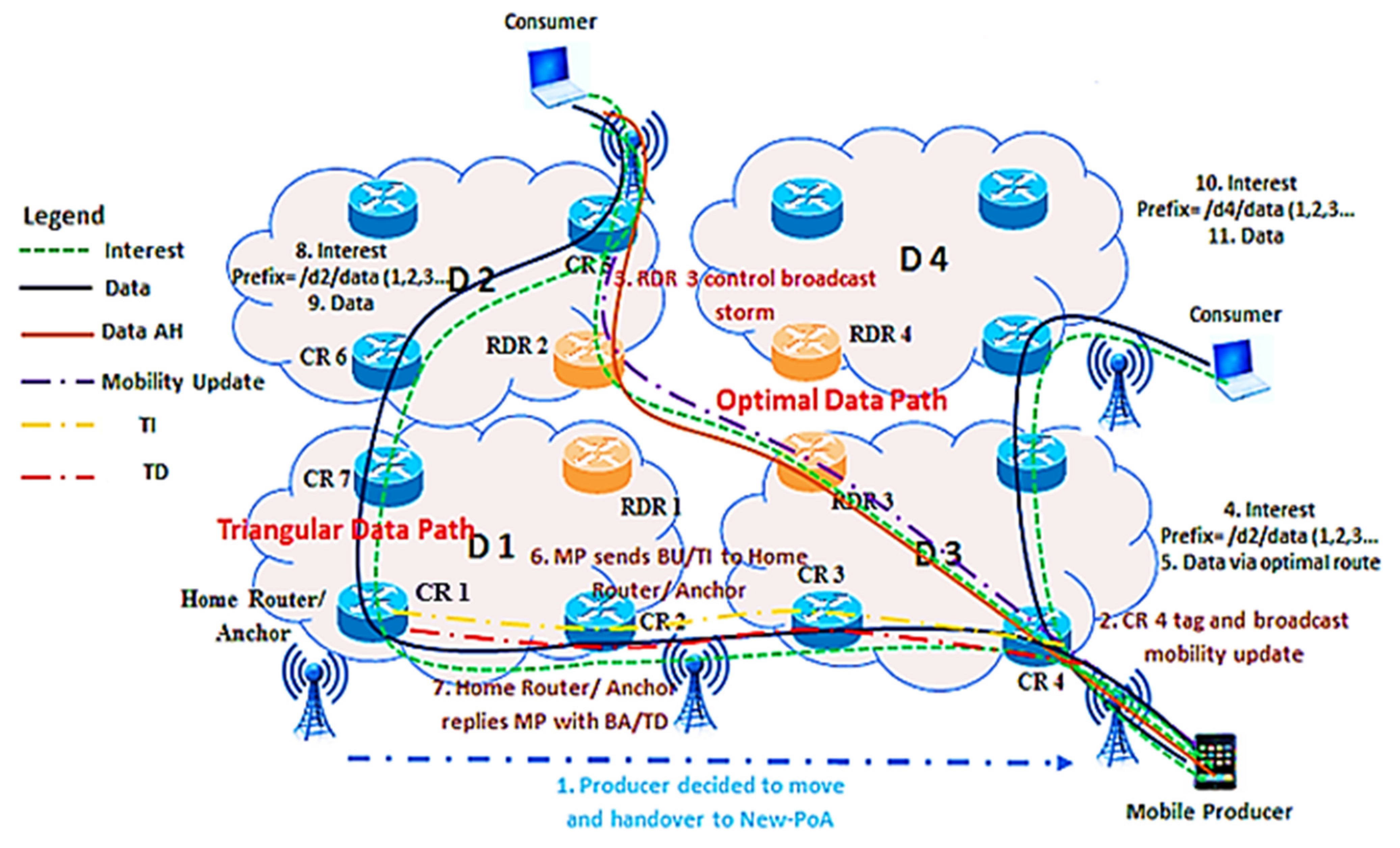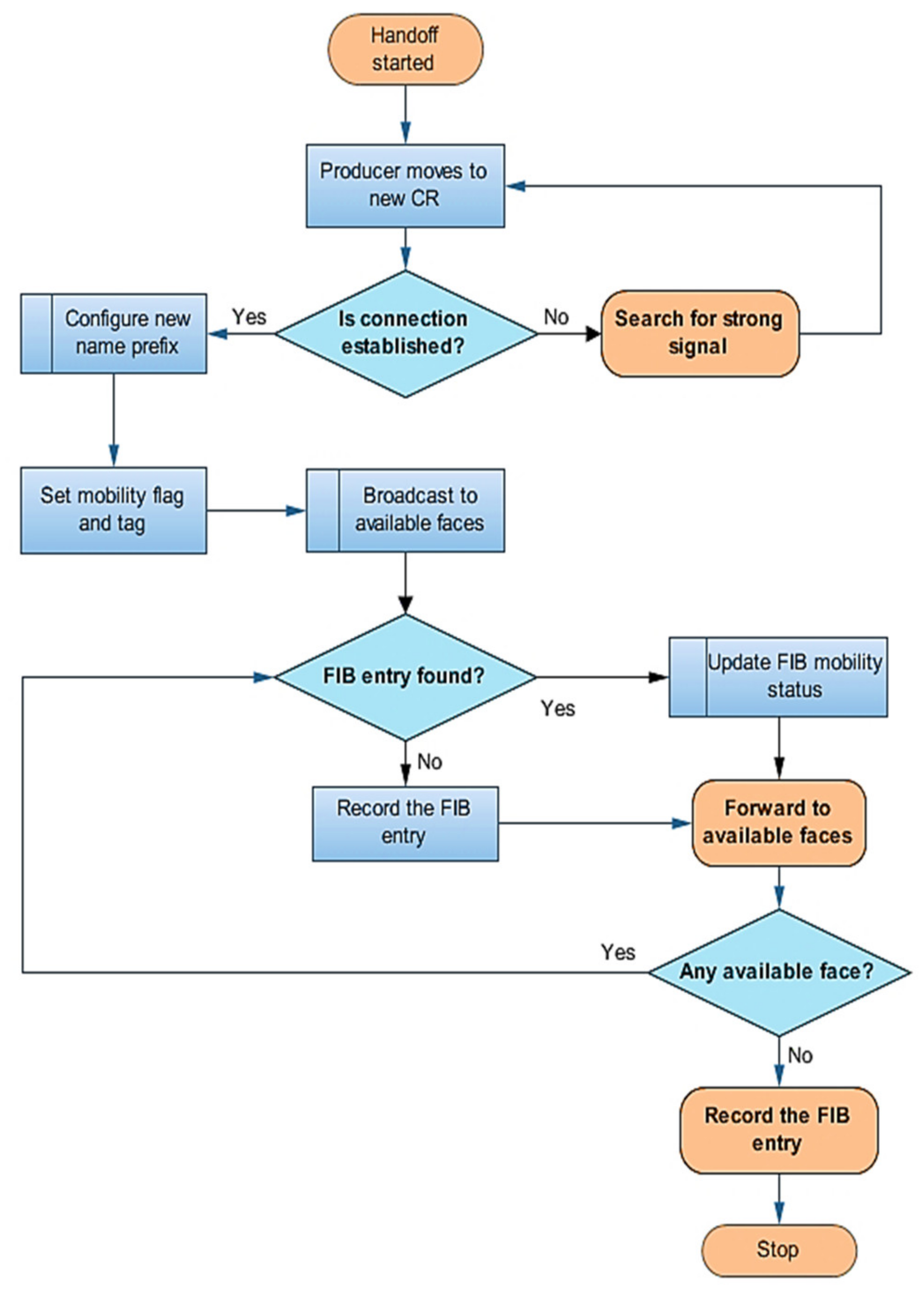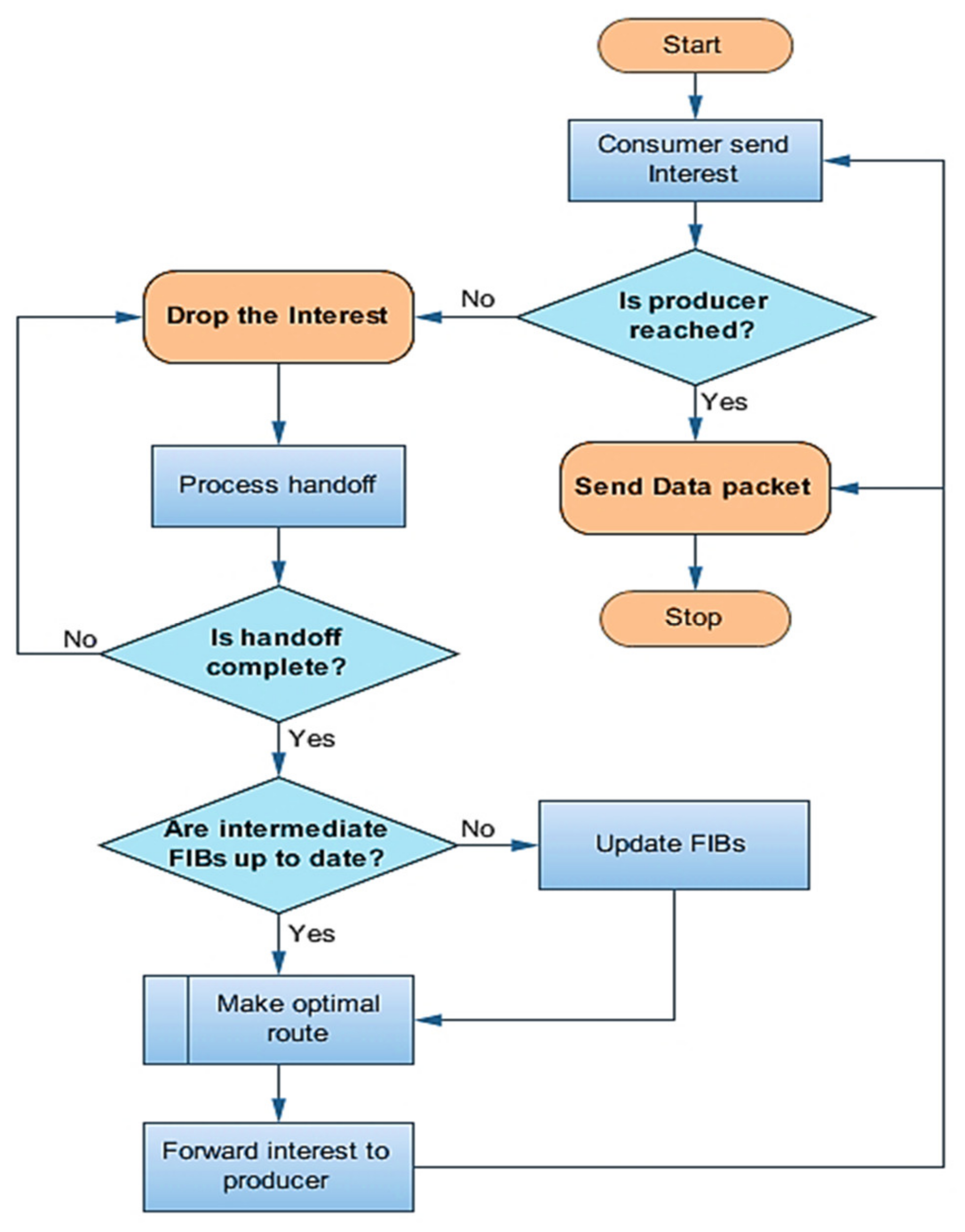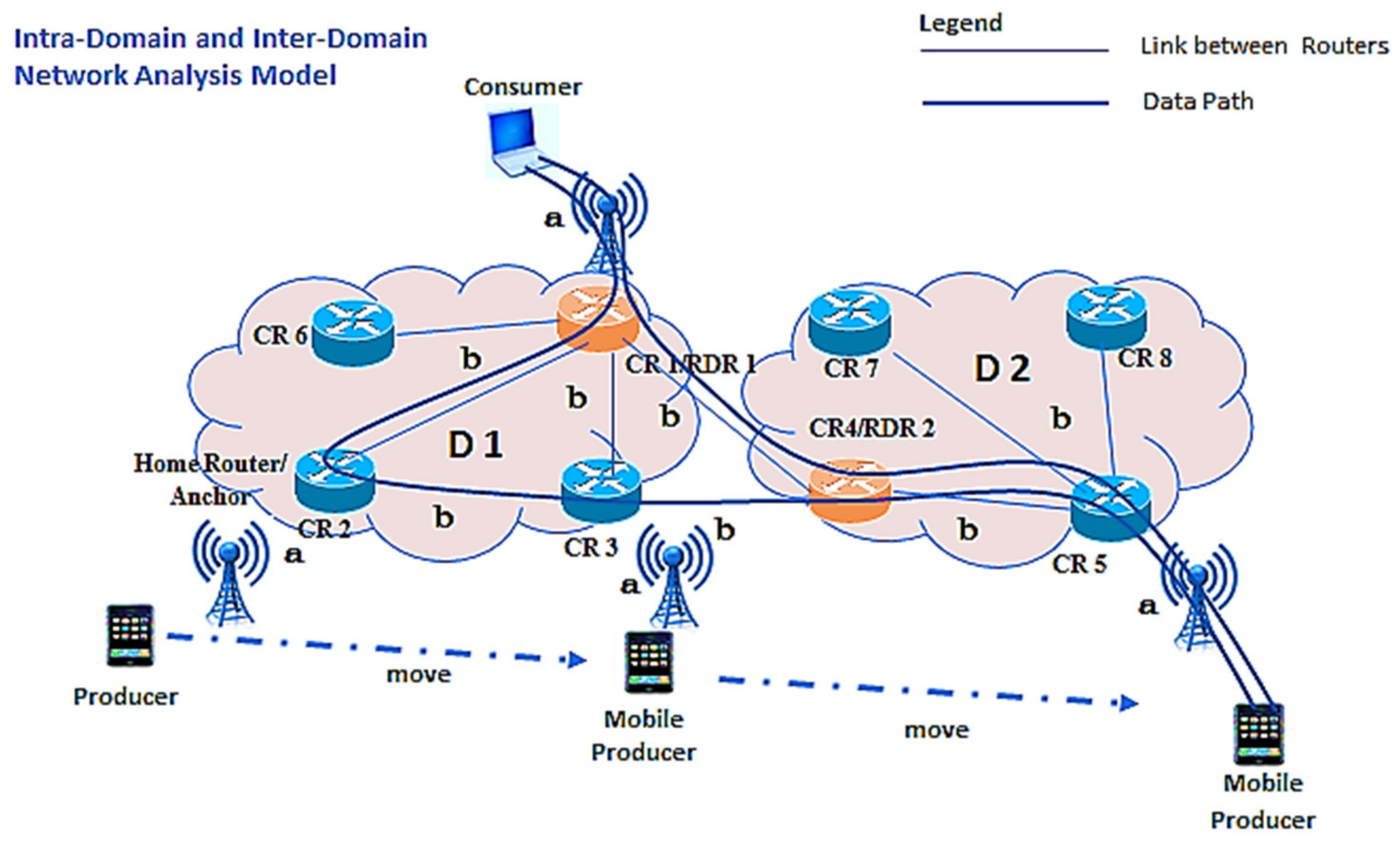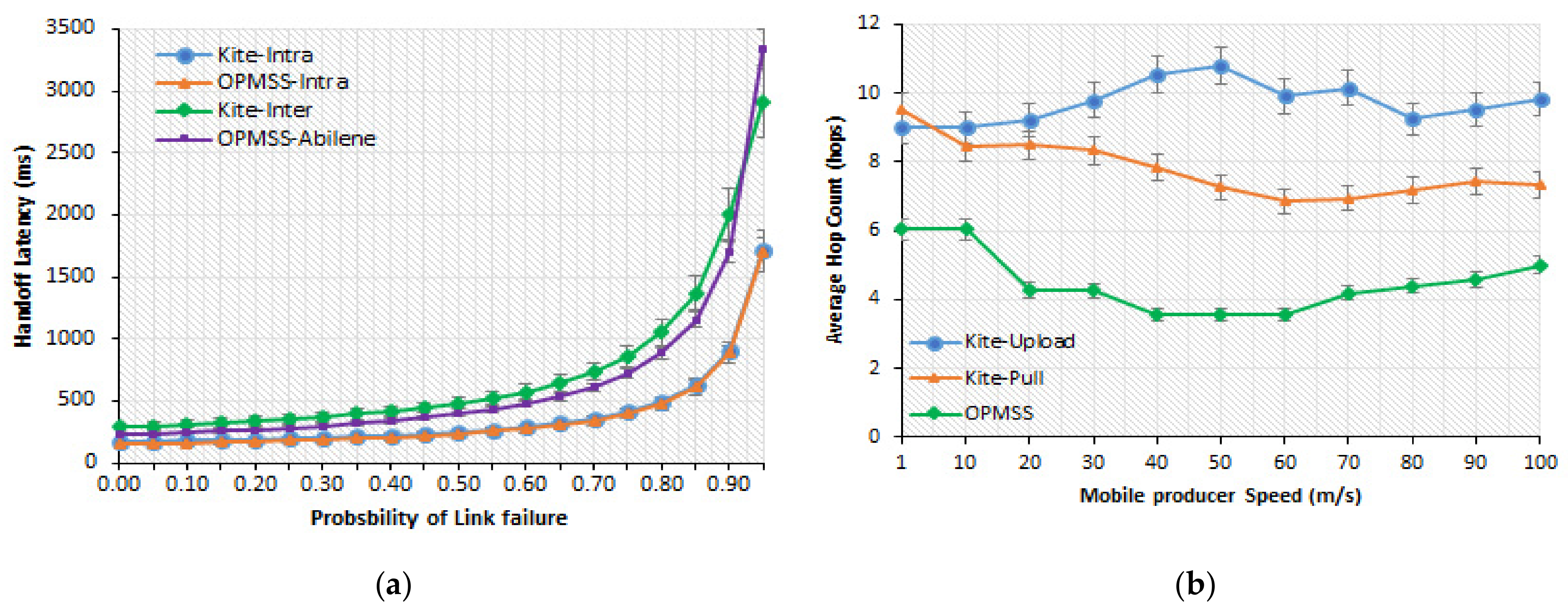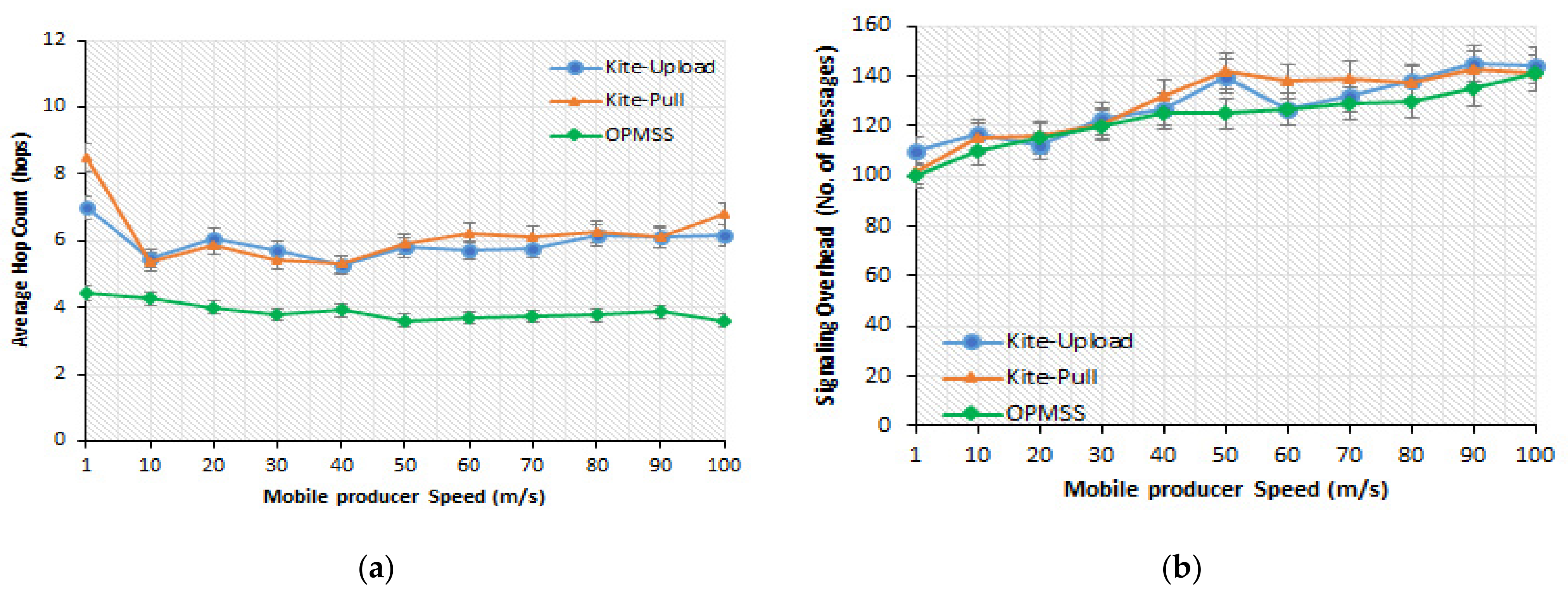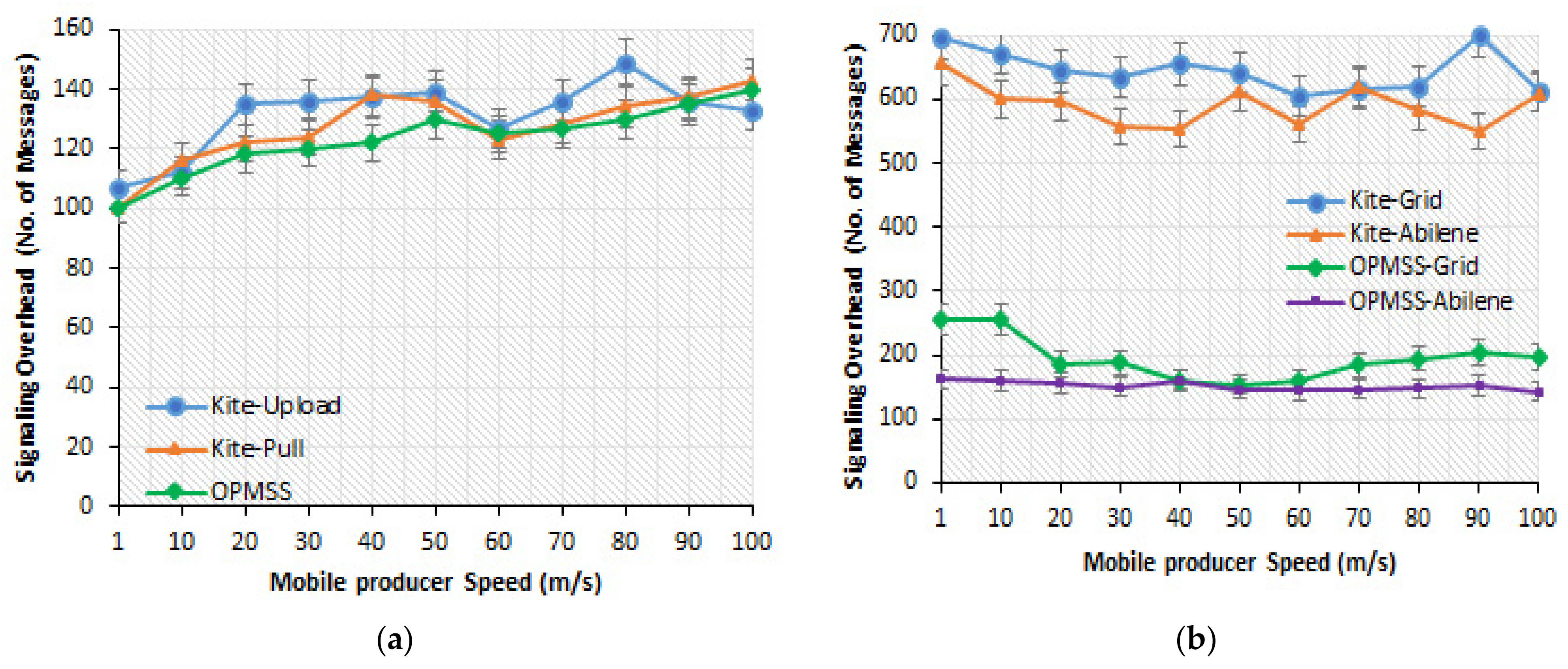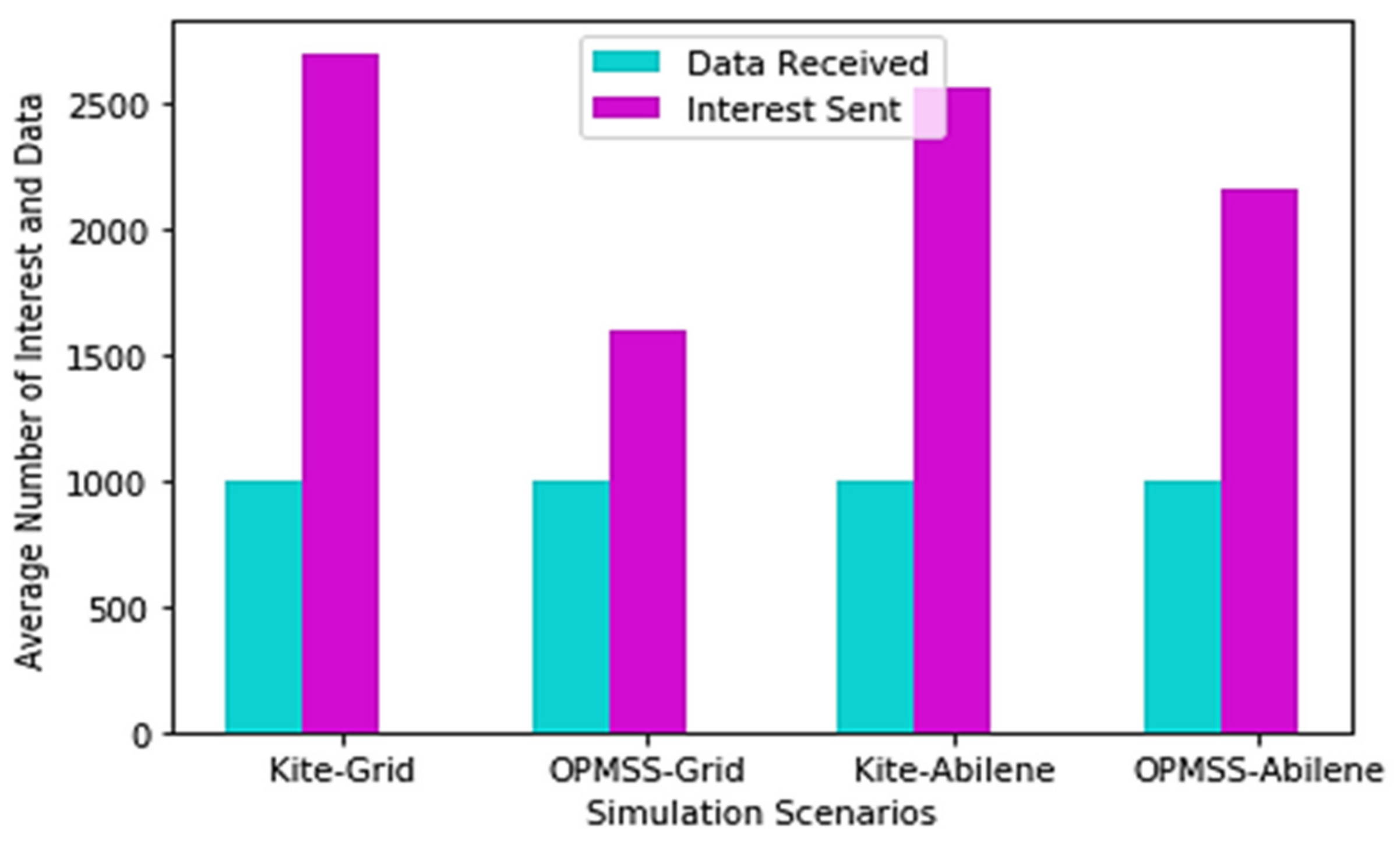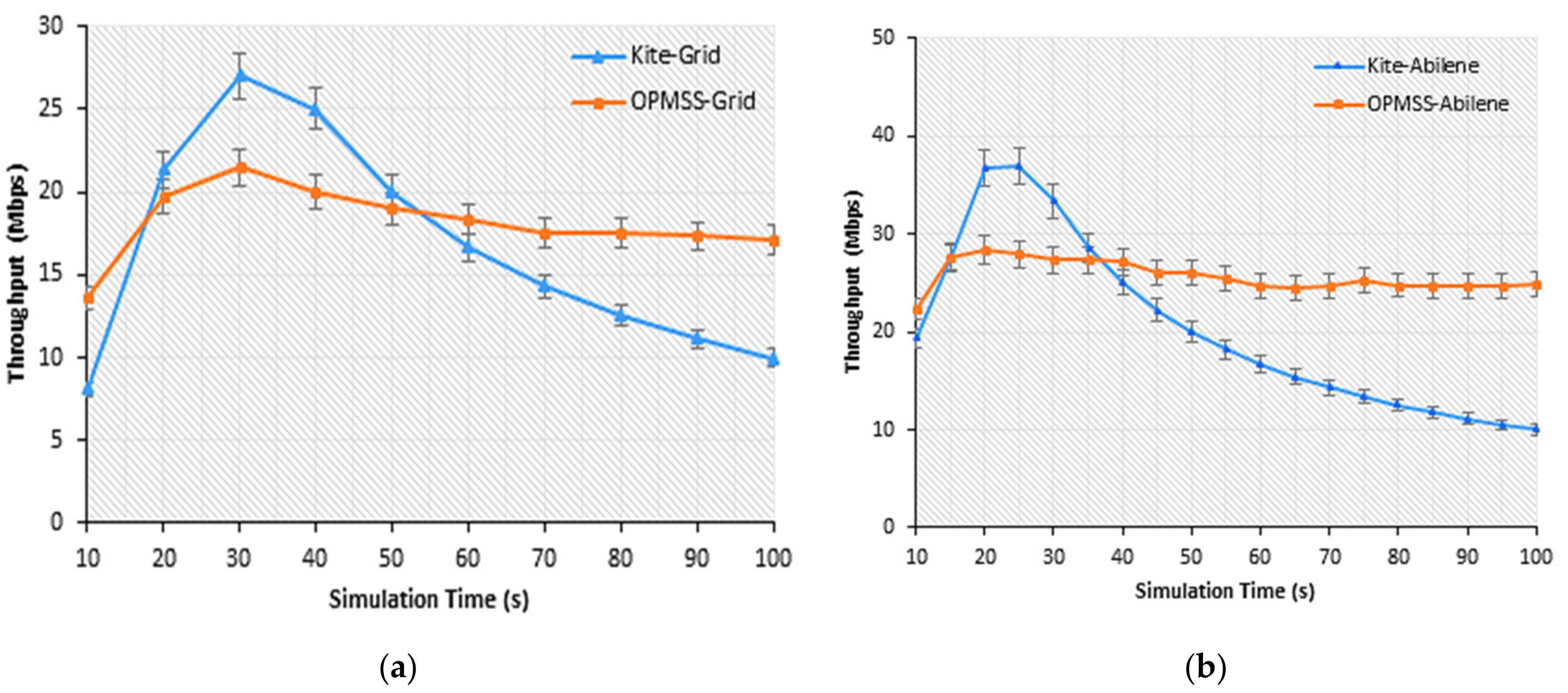1. Introduction
Based on Internet protocol (IP) architecture, the Internet has achieved exceptional success since its establishment, particularly with the advent of overlays such as peer-to-peer networking, web applications, wireless sensor networking, mobile networking, the Internet of Things (IoT), vehicular networking and content distribution networking. However, the nature of Internet use is rapidly changing from being host-based and emphasizing point-to-point connection to being content-centric and emphasizing the sharing of information. Moreover, the IP architecture is becoming complex due to integration overlays that result in ineffective content distribution, delays, insecurity, and high bandwidth consumption attributable to increased user demand.
Named data networking (NDN) is the prominent architecture under the umbrella of information-centric networking (ICN), which is designed as a clean-slate Internet architecture to replace the current IP Internet architecture [
1]. The named data networking was proposed to offer vast advantages, especially with the advent of new content distributions in IoT, 5G and vehicular networking. Fundamentally, NDN supports content consumer mobility due to the consumer-driven design principles and nature of in-network catching capabilities. Named data networking (NDN) architecture is recognized as a potential content-centric paradigm for wired and wireless domains. Its novel concepts, such as security, in-network caching, hierarchical naming or namespace, named content, and name-based routing, suit the requirements of IoT [
2]. Moreover, the architecture has the potential for efficient data dissemination and interconnecting billions of heterogeneous objects in an IoT network. Despite the benefits of NDN in an IoT network, the mobility perspective must be studied, and a concrete solution to support mobile IoT must be found [
2]. If mobile nodes are no longer reachable in IoT, the problem will worsen, as the mobile frequencies in intelligent transportation and eHealth applications are very important [
2]. In addition, the services that are based on NDN with blockchain technology can be applied in IoT for secured data management.
Decoupling senders and receivers, in-network caching, and the hop-by-hop transmission characteristics of NDN enable it to support 5G networks [
3]. The result of the potentiality is shown by information-centric networking (ICN), such as security, mobility, energy efficiency, and in-network caching, which are considered important in the 5G telecommunication network [
4]. In addition, ICN is promoted as a framework for virtual function provisioning and named content retrieval in 5G [
3]. The encouraging results of ICN have motivated certain technical specification organizations to promote ICN as an enabler of 5G, which evolved from 4G core network architecture focus on radio access networks, as an overlay on network function virtualization, and software-defined networking infrastructure [
5]. However, in adapting 4G, the drawbacks of IP architecture, which include tunneling technology to support mobility, high signaling cost, security challenges, and the lack of multihoming support, were inherited. Therefore, the inherent benefit of ICN with the support of name-based networking, security, in-network storage, in-network caching, and mobility is the ability to solve the inherited problems of the 5G network. In addition, the mobility management involved in network slicing-based 5G is challenging due to the high density and high mobility of devices [
6]. Consequently, the mobility support and in-network caching characteristics of NDN emerged in the architecture as promising candidates to integrate into 5G [
7].
NDN supports consumer mobility without additional mechanisms by using certain characteristics, such as its consumer-driven nature and in-network caching [
8,
9,
10]. NDN design principles inherently support content consumer mobility; for example, when the physical location of a consumer changes, there is no effect on the data plane, unlike with IP [
7]. The retransmission of requests can take place without additional signaling to the network. However, challenges arise in relation to real-time group communication and content producer mobility, depending on the content lifetime, latency requirements, and frequency of the producer’s movements [
7]. Zhu, Afanasyev, and Zhang [
11], the creators of NDN, note that NDN does not support the mobile producer. In addition, they recommended that to provide a solution to producer mobility support, the separation of name prefix identifier and locator from the single hierarchical name prefix in NDN is necessary. Moreover, the prefix identifier and locator can be mapped using the broadcasting method or DNS servers [
11].
The problem of producer mobility can be lessened via caching and providing a mobile producer handoff solution. In [
12], the author emphasizes the natural support of mobile consumers and states that alternative cached copies can be used by consumers after relocation. The authors report that consumer mobility is intrinsically supported. However, there are many challenges with producer mobility that started with the initial design of NDN, such as long handoff latency, high handoff signaling costs, table size scalability problems, unnecessary interest packet loss, and the high cost of bandwidth utilization. Therefore, producer mobility is not supported in NDN, as the initial proposal of NDN claimed the missing of producer mobility support and passive consumers [
13], hence, a sustainable solution is required to make NDN a promising architecture that can supplement the future Internet with the integration of 5G [
14], IoT [
15], and other network overlays that require mobility support. By solving the mobility problem inherited from IP architecture, NDN can successfully become future Internet architecture [
16]. Hence, the researchers are motivated to conduct the highest research records in NDN mobility support between 2017 and 2018, due to the anticipation of NDN capability to incorporate other networks without additional mechanisms. Cisco proposed hybrid ICN (CCN and NDN) in a 5G network [
17], which encouraged many researchers to investigate integrating ICN into 5G networks [
5,
18], NDN-5G-SDN support [
18,
19], ICN with IoT networking [
20,
21,
22], and NDN-based vehicular ad hoc networking [
23].
Therefore, much research was conducted from 2012 to present, to find the solution to producer mobility using, for example, the location-based approach, the mapping-based approach [
24], the tracing-based (TB) approach [
25], the indirection-based (IB) approach [
26], and the anchor-based (AB) approach [
27]. The mapping approach utilizes a mapping point, such as DNS server [
28], a rendezvous server (RS), or a resolution handler server [
24], to update the network about the new name prefix of the mobile producer to provide optimal data packet delivery after the handoff. However, the approach has a high signaling overhead cost due to the server query and update, which may result in long handoff latency. The IB approach uses an indirection point of the home router, a rendezvous point, or an anchor node [
29] to store the new location and traced information for the request forwarding to the mobile producer. The approach provides normal handoff signaling and latency, but triggers a path stretching problem due to triangular routing. In addition, the representation of indirection points can become a single point of failure.
Moreover, this paper aims to provide a solution to producer mobility in NDN, reduce the handoff signaling and latency, provide an optimal path by addressing the path stretching problem, addressed the interest packets loss, and avoid the single point of failure from the indirection-based approach. In fact, is proposed as the improvement of our previous work [
30] that introduced the concept of using a broadcasting strategy to provide an optimal route after handoff, which was analyzed using an initial and reference model as evident limitation. In addition, analytical mobility model was used to validate the conceptual model presented in the previous work, and the result is limited to numerical analysis on handoff latency, signaling cost and data delivery. Further, among the benchmark schemes, there was a Kite scheme that was limited to analytical evaluation method, whereby the result obtained cannot be generalized [
30]. However, this paper proposed a novelty for the design and implementation of an updated broadcasting strategy, which includes the design of mobility interest (MI) packets to update mobile producers’ new information. We further used the broadcast method to design a broadcasting strategy to update the forwarding information-based (FIB) tables of the intermediate routers. Similarly, a best-route strategy was used after FIB updates to guarantee data path optimization. Moreover, the restricted domain router (RDR) was introduced to curtail the problem of broadcasting storm during intra and inter domain mobility. Correspondingly, the proposed OPMSS is designed and implemented using ndnSIM simulator, that have the standard NDN stack as a new network-layer protocol model. The result is not limited to only handoff signaling, latency and data delivery, but throughput, data packets and interest packets losses are considered.
The paper is organized into seven sections, apart from the introductory part,
Section 2 consists of a review of the existing approach. In addition, we highlight the research gap that this paper addresses.
Section 3 discusses the design processes of the proposed optimal producer mobility support solution.
Section 4 presents the formulation analysis of the proposed solution.
Section 5 presents the details of the implementation of OPMSS in ndnSIM, performance evaluation of both the proposed and the existing producer mobility solutions.
Section 6 consists of the overall discussion, followed by the conclusion.
2. Related Works
To achieve the routing and forwarding of packets, NDN uses named-base routing and possesses of two different types of packets, namely interest and data packets. Additionally, the NDN node can be represented as client consumer, producer or a router, which maintains three aspects—data structure pending interest table (PIT), forwarding information base (FIB) and content store (CS)—and determines when and where to forward data and interest [
1,
31]. For the purpose of PIT records and storing any incoming interest information, FIB maintained the forwarding strategy and decided when and where to forward interest and CS; this is a temporary cache of data stored based on NDN caching policy. The network was set up and the client node (consumer) was established as a connection in the network. When the consumer intends to retrieve data from the network, it will send an interest to the NDN router. On arrival of the interest, the router checks the CS for matching data; if found, it forwards the data packets back to the consumer. Otherwise, the router looks up the name content in its PIT for matching entries—if the entry is not found, it will record the name content and incoming interface and forward the interest to the next hop through FIB, otherwise it will aggregate and record the interface only. The same process takes place up towards the content producer. Interest can be dropped on certain circumstances depending on the forwarding strategy, e.g., the congestion of upstream links or security breaches by suspecting interest to be part of DoS. Once the data producer receives an interest request from the home router and its PIT, and finds the required content, it will forward the data packets back through the interface that received the interest to the downstream interface recorded in PIT [
32,
33].
2.1. Producer Mobility Support Approach
NDN was introduced as promising Internet architecture to replace IP Internet, particularly from the perspective of mobility support. Many researchers adopted the mobile IP concept called the indirection-based mobility approach (IBMA) to solve the mobility problem in ICN, particularly NDN. The indirection-based concept is explored more, as it is inherited from the IP mobility solution concept. In addition, the concept does not attract additional network infrastructure, which is one of the benefits of NDN architecture. Our study tackles the problems related to the IB approach’s path stretching or data packet delivery optimization problem. Moreover, many areas that are booming, such as Internet-of-Things (IoT), vehicular Internet-of-Things (VIoT) and vehicular named data networking (VNDN), are employing NDN architecture for a proper solution related to mobility and data dissemination.
Due to the relevance and important features of NDN for mobility support of the field Internet-of-Things [
34], vehicular Internet-of-Things (VIoT) [
35] and Internet-of-Things Cloud (IoTC) [
15], it employs the NDN architecture for the solution of data retrieval and node mobility. Wang [
15] proved that deploying NDN in IoT is quite challenging, due to the different architectures and working mechanisms and the effective mobility support strategies in NDN being lacking. The author [
15] proposed an efficient framework for NDN-based IoTC, aiming to provide effective and improve data retrieval success, by employing a unicast method to obtain data from the nearest node and support node as a consumer or producer on mobile. However, the proposed framework is not solely for NDN mobile producers that have clear differences with the consumer. This means that the name prefix announcement is not considered as a unique feature of the producer. Moreover, the solution did not evaluate the handoff latency and signaling performance. Vehicular named data networking (VNDN) is a new paradigm proposed to facilitate communication between vehicles [
36]. NDN proved to be a promising future Internet under the ICN paradigm which supports any vehicular networking [
36,
37]. Al-qutwani in [
37] stressed some challenges, such as node mobility related to packet forwarding, which still need to be addressed. The broadcast strategy is used for the proposal of request/advertise-based content forwarding approach to solve the issue of node mobility and forwarding performance [
37]. The content consumer broadcasts a message named request and content provider advertise contents in the same way as the consumer, by using an advertisement message. The solution gives the provider or consumer the opportunity to find desired data packets with minimal delay and overhead. In addition, the proposed solution can help a mobile producer to change location and use an advertisement message to announce its current position [
37]. However, the solution may cause a very high signaling overhead when the number of mobile producers increases; this is due to the usage of request and advertisement messages in line with data and interest packets.
Recently, a number of producer mobility schemes were proposed as in [
34]. The solution is an NDN producer mobility scheme that requires no use of anchor; there is no need to announce the producer’s movement to the nodes over NDN architecture and the scheme does not modify the current NDN router. It exchanges a pair of data and interest packets during a normal transaction. The proposed scheme support producer mobility introduces a dual connectivity to both hide the link breakage to the NDN, and a new NDN link service is created separately which is called the producer mobility link service (PMLS), which is used to repair the old link so that the connectivity with the previous NAR can be maintained and force the router to buffer the interests arriving during the movement transition period, forwarding them to the producer after the completion of the handoff [
34]. However, in the process of buffering the interest packets, latency and signaling will be high before the old link is repaired due to the exchange of update and status messages other than normal interest packages. Moreover, the buffer zone requires a high amount of storage, especially in the bigger, and denser, mobile producers’ environment. Furthermore, a mechanism using the spatial locality of moving producers was designed to support producer mobility. The solution maintained the reverse paths of data similar to the original ICN of NDN architecture [
38]. The mechanism is modeled using hop count forwarding strategy that considered a weighted sum of the round trip time (RTT) as the average service time between the consumer and every intermediate node [
38]. However, the sole use of RTT cannot determine if there is congestion among the intermediate nodes which allow the consumer to keep on sending the unsatisfied interest packets. Therefore, for ICN to support multi-access edge computing for 5G technology of anywhere–anytime connected services for mass mobile connectivity, the movement pattern of mobile content producers needs to be investigated [
14].
2.2. Anchor-Based and Tracing-Based Methods
The AB and TB methods are typical examples of IBMA solutions. In the AB method, the immobile anchor router or resolution server (RS) is placed in the network when the mobile producer moves to a new location and obtains a new prefix name. The new prefix is then sent to the anchor router or the RS. Next, the consumer sends a pending interest packet to the known location of the anchor router, and the anchor router tunnels it to the new location of the mobile producer. Unlike in the TB method, the anchor router or RS utilizes the traces of the mobile producer stored in pending interest tables (PITs) or FIB tables. When the interest packet arrives, the anchor router or RS forwards the interest along the traces without tunneling.
Zhang et al. [
25] proposed a TB solution called Kite that utilizes the PITs and FIBs to store mobility traces and reach the new location of the mobile producer through routable anchors [
13]. This scheme is also called an AB approach [
27] or a PIT-based approach [
39], where a mobile producer sends traced interest or trace interest [
25] packets to the immobile anchor or the RS and establishes a trace route in the PITs of the intermediate routers, and sends the new location of the mobile producer to the anchor router or RS. The traced or trace interest packets, as presented in a report about the Kite mobility solution, can be sent to the immobile server or the data deport. The corresponding node, consumer, immobile server, or data deport requesting content sends tracing interest packets as in [
13] or traced data as in [
25] back to the anchor router or RS. In the latest Kite report, the RS announces a routing prefix and the mobile producer issues a trace interest packet with a special tag to the RS. The RS verifies this and responds with trace data to update the intermediate routers as trace setup processes [
25]. The consumer sends an interest packet to the RS and then forwards the trace to the mobile producer. These processes are similar to those in a previous Kite solution, except for the change of tracing and traced interest packets that are replaced with trace interest (
TI) packets and trace data (
TD) in addition to the consumer’s interest packet. However, the Kite solution results in high signaling to keep the traces active, along with the intermediate router in PITs, by sending
TI packets and
TD in a timely fashion. Moreover, the solution results in path stretching, where the optimal routing path is not guaranteed because the consumer’s interest packets pass through the RS or anchor point.
An attempt was made by Kim and Ko [
27] and Do and Kim [
39] to improve the Kite solution by providing an optimal routing path and reducing the signaling overhead cost. Do and Kim [
39] proposed a scheme for a large-scale NDN to solve the path stretching and routing problem of the Kite solution and to reduce the signaling overhead cost. The author [
39] introduced a fast handoff mechanism that directs the subsequent interest packets to the new location of the mobile producer and creates an optimal data path. A special mobility management packet is used to make the update before the handoff occurs. The scheme uses a forwarding plane of NDN to establish an optimal data delivery path and predict producer movements. However, the solution is not guaranteed for large deployment, as claimed by the author. In addition, due to the processes of fast handoff, the signaling overhead cost becomes higher, and the addition of a binding cache and neighbor information tables increases the look-up time.
Kim and Ko [
27] proposed an on-demand anchor-based solution to producer mobility that uses a mechanism called adaptive interest packets forwarding. When the producer moves to a new location, the FIB entries become invalid, and the interest packets looking for the content from the mobile producer are redirected towards the anchor node from the previously known location of the producer, instead of being dropped. The mobile producer keeps on updating the anchor node with mobility update packets whenever there is movement. When the interest packet has been redirected to the anchor node, it uses the traces in the mobility update and forwards the pending interest packet. The solution aimed to reduce handoff delay and signaling overhead costs caused by the blind flooding of
TI and
TD in the Kite solution [
27]. However, the solution ends with a path stretching longer than that of the Kite solution, which provides perfect triangular routing. Therefore, path optimization is not considered, and the anchor’s placement becomes critical [
7] and becomes a single point of failure.
In the Kite solution [
25], we can assume that a mobile producer is disconnected from the current router and directly reconnected to the new router. The mobile producer sends a
TI message with a special trace tag to the known location of the RS or the anchor router. The RS verifies and responds with a
TD message along the path that
TI is received, and the trace created along with the intermediate routers by updating the FIB tables between new router and the RS. When a consumer sends an interest packet to the RS requesting new or unsatisfied content, the RS forwards it to the new location of the mobile producer (new router) via the trace. The process of trace set-up continues whenever the producer moves to a new location. The Kite solution allows the mobile producer to keep the trace alive by exchanging
TI and
TD.
In the proposed OPMSS, when the mobile producer relocates to a new location, it configures and sends an MI packet for a new name prefix update. The mobility tag is attached to the name prefix and is broadcasted to the FIB table’s update domain. Upon receipt by the restricted domain control router, the router will determine the domains that need to rebroadcast the MI packet based on the old prefix information. The routing plane then creates an optimal path between the consumer and the mobile producer.
2.3. Broadcasting Method
The broadcasting of interest packets is a practical aspect of NDN; therefore, much of the research has used the broadcasting method in different sub-fields of networking to enhance the performance of NDN. Vehicle-to-NDN [
40], vehicle-to-vehicle NDN [
41,
42], and wireless NDN [
43] utilize the broadcasting method for data and interest communication to support moving contents, although some additional methods, techniques, or mechanisms have been added to mitigate broadcasting storms. Siris in [
44] proposed a popularity-aware intra-domain content mobility management solution that uses broadcasting and a name resolution service. The model utilizes a name resolution system (NRS) to update the network about the new location of the mobile producer when there is high popularity content and low mobility, while broadcasting of the location queries is used when the content popularity is low and there is high mobility [
44]. The solution provides mobility support and significantly reduces signaling overhead costs. Asif and Kim [
45] proposed a location-aware on-demand multipath protocol that uses a broadcast transmission mechanism to transmit data and interest packets. The packets are transmitted via multiple routes to the new location of the mobile producer. In addition, a relay node is used to control high signaling and to prevent intermittent connectivity and packet flooding that negatively affects network performance.
Shi, Newberry, and Zhang [
46] showed how broadcast-based self-learning is applied to solve the trust and name-prefix granularity problem in NDN networks. The broadcast-based self-learning mechanism is used to find the delivery path of packets when content is moving within the network [
46]. Therefore, in this paper, a broadcasting strategy is designed to utilize
MI packets to update intermediate routers when the producer relocates to a new point of attachment (PoA). The
MI packets are similar in function to the traced and tracing interest in [
25] the binding update or forwarding hint in [
47], and the mobility management packet in [
39]. In addition, a network domain is restricted as in [
11] to control broadcasting storms and to prevent high signaling.
2.4. Overview of Kite Scheme Operation
Kite is a popular NDN mobility support proposed by Zhang et al. as part of the architectural development of the NDN project. In this paper, we categorized Kite as tracing-based mobility support approach reviewed and briefly explained in
Section 2.2. To gain a clear understanding of the Kite operation, the following steps describe the process before, during, and after handoff, as shown in
Figure 1. Moreover, the name resolution for tracing of mobile producer is normally take place by the anchor router or RS in Kite scenario, however, in
Figure 1, the anchor router is used.
Steps before the handoff, when the consumer is connected to CR1 and the producer is connected to CR4
Step 1: Normally, a consumer sends an interest packet requesting data to CR1. CR1 then checks if the content is available; otherwise, it floods the NDN network with the interest packet.
Step 2: The prefix data name within the interest packet passes through routers to the location of the producer. If the data are cached by any router in the network, the router will immediately respond with the data back to the consumer. Otherwise, the routers along the way will record the interest information in the PIT and the FIB table as entries and forward it until the content producer is reached. The producer then sends the data to the consumer in a breadcrumb style.
Steps when handoff starts
Step 3: The producer suddenly decides to move and connects to CR4.
Step 4: A new content name prefix is formed after the connection, and the producer gets ready to update the anchor router (i.e., CR1 from
Figure 1) or RS about the new name prefix.
Step 5: The producer floods the network with the TI packet via the anchor router or the RS to update the system about the new name prefix.
Step 6: The anchor router or the RS respond with trace data packets and establish a trace between the mobile producer and the anchor router or the RS through CR2, CR3, and CR4.
Step 7: The content consumer could not trace the new location of the producer after sending the pending interest packet.
Step 8: The consumer will send the pending interest packet to the well-known location of the anchor router or the RS.
Steps after handoff
Step 9: The anchor router or the RS forward the consumer’s interest packet via the established trace to the mobile producer.
Step 10: The mobile producer replies to the consumer with the requested data packets via the anchor router or the RS.
Despite the advantages of the Kite scheme that outperforms the mapping-based approach in terms of handoff delay with similar signaling overhead when a mobile producer moves frequently, the optimal data path is not guaranteed in such a way that consumer’s interest packets always pass through the immobile anchor or RS. Hence, the Kite scheme falls into the category of an indirection-based approach that can make the forwarding path longer than the path computed in the normal NDN routing plane. This is called the path stretching problem, as the provision of the optimal path was not considered, consequently, making the handoff latency higher. Additionally, there is no improvement in signaling cost minimization compared to the mapping-based scheme for both the pull and upload pattern of Kite solution.
The proposed OPMSS have more advantages over the existing Kite solution, in such a way that MI packets alone can easily represent the functionality of TI and TD packets of Kite, hence the high signaling caused by the exchange of TI and TD can be minimized. Furthermore, the broadcasting strategy proposed in OPMSS provides a solution to the problem of the single point of failure caused by immobile anchor or RS in Kite solution. When MI packet is broadcasted, there is no need for an RS or an immobile anchor router in the processes of data and interest exchange. Conclusively, the MI packet and broadcasting strategy solve the path stretching the problem of Kite; once the FIBs of the intermediate routers are updated with the new routing name prefix, the interest can find the shortest route the new location of mobile producer without passing through the RS or immobile anchor router.
5. Performance Evaluations
Numerical evaluation is used, as in [
49,
50,
51], for the handoff performance evaluation. However, the numerical evaluation only is not enough to cover the peculiarities of producer mobility. Hence, both numerical and simulation-based investigations are used for the evaluation of handoff performance, as in [
7,
25]. Therefore, the performance of OPMSS is evaluated using both numerical and simulation investigation, specifically for the evolution of unnecessary interest packet loss, the provision of data path optimization, reduced handoff latency, signaling cost, and good data delivery. The numerical evaluation considers handoff performance, such as handoff latency, signaling cost, and data delivery via the optimal path.
5.1. Numerical Evaluation
The parameters in
Table 1 are used to investigate OPMSS in terms of minimal handoff latency, signaling cost, and path optimization. A numerical evaluation is conducted as in previous research [
8,
51] using a network analysis model based on Equations (3)–(14) presented in
Section 4.
The handoff latency is the time it takes a mobile producer to receive a pending interest packet from the content consumer after completion of the handoff. In OPMSS, the time that the
MI message takes to update the intermediate FIB tables is measured based on the number of hops between the content consumer and the mobile producer. In the Kite solution, the time taken for the exchange of
TI and
TD messages between the anchor router or RS and the mobile producer to create traces in the FIB tables, and in addition, the time taken for the pending interest to reach the new location of mobile producer in both PMSS and Kite solution.
Figure 6 shows the summary of the numerical handoff latency results for OPMSS and the Kite solution that covered both inter-domain and intra-domain motilities that are measured against wireless link failure. To discuss the intra-domain and inter-domain handoff latency performance of the proposed OPMSS and the Kite solution, observations, justification, a quantitative analysis, and inferences are needed to determine the best solution.
The handoff latency results are achieved by plotting total handoff latency measured in milliseconds against the probability of the link failure of the mobile producer.
Figure 6a shows that OPMSS has 11% lower latency than the Kite solution for intra-domain mobility. The minimum handoff latency is 150 ms for OPMSS and 169 ms for the Kite solution. Furthermore, the handoff latency of OPMSS is less than 20% compared to the Kite solution for inter-domain mobility, with a minimum of 229 ms for OPMSS and 289 ms for the Kite solution. Therefore, OPMSS has better handoff latency performance for both intra- and inter-domain mobility compared to the Kite solution. However, at
q = 0.9 onward, we can observe that the latency of OPMSS increases by 10% compared to the Kite solution. This is because the Kite solution is able to manipulate the network by keeping the trace update alive. The OPMSS needs to reconnect and broadcast the
MI packet to the domain, because when the link fails, the mobile producer may not be reached. Overall, despite the possibility of total link failure, OPMSS has better handoff latency than the Kite solution.
The OPMSS solution is implemented in an NDN simulator called ndnSIM that operates based on an open source NS-3. It offers reliable simulation results, particularly for a name-based architecture popularly known as ICN. The ndnSIM allows the transfer of simulated experiments to real practical applications. The simulator is implemented using different C++ programming methods to model NDN architectural behavior, such as the FIB table, CS, PIT, and interfaces of communication with other nodes. The benchmark solution known as TB or the Kite solution is already implemented in ndnSIM, and the codes are available to reproduce the results. The Kite solution is rerun in the same environment with OPMSS to evaluate and compare their performance.
The operating system used for the simulation implementation of OPMSS is Linux distribution Ubuntu 18.04 LTS, which is open source and compatible with many open source simulators. This is followed by NS-3, a discrete-event network simulator that puts the emphasis on layers 2, 3, and 4. NS-3 is commonly used to model Internet systems and communication networks. NS-3 is integrated with ndnSIM 2.3, and both are configured in Ubuntu 18.04 LTS for a successful simulation experiment.
5.2. Simulation Parameters
The parameters used in this simulation relate to the mobility model, speed, number of mobile producers, topologies, and NDN set-up. Two different topologies, Abilene and the 4 × 4 grid, are used for two different scenarios. The speed of the mobile producer ranges between 0 m/s and 100 m/s, depending on the scenario set-up. A summary of the parameters with their respective values is presented in
Table 2.
5.3. Simulation Scenarios
In this experiment, there are two simulation scenarios for the Kite solution and OPMSS. The two scenarios are based on the 4 × 4 grid and Abilene topology. In scenario I, the infrastructural topology is a 4 × 4 grid that consists of 19–23 nodes, with a distance of 100 m between them. Among the nodes, there are three consumers and one mobile producer by default, and the simulation runs for 100 s. The content mobile producer moves randomly within the 400 × 400 square area covered by a different access point (AP) at a varying constant speed of 10 m/s–100 m/s. The grid nodes serve as routers and APs. Scenario II differs from Scenario I, as it consists of 12–13 nodes in an Abilene topology. Among the nodes, the mobile producer’s number varies from 1 to 5 and the simulation runs for 100 s, while producers move randomly at constant speed varying from 1 m/s–100 m/s by taking the interval of 10 m/s into consideration. The scenarios are run for the Kite solution and OPMSS.
The handoff performance of OPMSS is evaluated and benchmarked with the Kite solution using numerical investigation and a simulation experiment to ensure our proposed solution reduces unnecessary Interest packet loss and provides optimal packet delivery, good throughput, and a good packet delivery ratio.
5.4. Simulation Evaluation
Simulations for OPMSS, Kite upload, and pull pattern are run for 100 s, under two scenarios with different infrastructural topology. The mobile producer is randomly moving within the bounds of the random walk mobility model for each simulation executed. In OPMSS, the restricted domain routers are placed at nodes 5, 6, 9, and 10. The consumer node is connected to node 15 for the 4 × 4 grid topology and is connected to nodes 3 and 7 for the Abilene topology. For the Kite upload and pull pattern, the server or consumer node is connected to node 0 for the grid topology and to node 15 for the Abilene topology, while the RS node is connected to node 0 and node 1 for the grid topology and the Abilene topology, respectively. The simulation is conducted for different speeds of the mobile producer; the results are presented in
Figure 6b.
The results of handoff latency and data path stretching can be determined by observing the hop count distances between the consumer and the mobile producer. The average hop count result is obtained against the speed of mobile producer that is varied for the two scenarios. The results are plotted in a graph with average hop count on the
y-axis against the speed of the mobile producer on the
x-axis as presented in
Figure 6a,b, respectively. The figures present the average hop count results that prove the solution to the path stretching problems of the Kite solution compared with the proposed OPMSS.
The results of the grid topology scenario show that when the speed of the mobile producer increases, the average hop count decreases for both OPMSS and the Kite pull pattern, while that of the Kite upload remains unstable. The overall average hop counts of OPMSS are 46% and 42% lower than those of the Kite solution, as shown in
Figure 6b, and are 34% and 37% lower in
Figure 7a for both the upload and pull pattern. The hop count in the Kite upload pattern is higher than in OPMSS and the Kite pull pattern; this is because in the Kite upload, the consumer must establish the trace from end to end, without a half-way trace due to the absence of an RS. OPMSS has a lower average hop count due to the advantage of
MI packets being broadcast, which updates all the FIB tables of the intermediate routers and establishes an optimal route between the consumer and the mobile producer. The low average hop count proves that the proposed OPMSS has better handoff latency and solves the path stretching problem of the Kite solution for both the grid and Abilene topologies.
The handoff signaling cost results for the two different scenarios are plotted on the graph; the
y-axis represents the handoff signaling overhead cost, while the
x-axis represents the speed of the mobile producer.
Figure 7b and
Figure 8a present the average signaling overhead cost of OPMSS and the Kite solution for both the upload and the pull pattern. The results show that despite the broadcasting nature of OPMSS and the help of the domain restriction application, the outcome is encouraging. The Kite solution is considered very good in terms of having minimal handoff signaling overhead compared to the mapping-based approach and the control/data plane-based approach. The results shown in
Figure 7b and
Figure 8a reveal that OPMSS has nearly equal or less handoff signaling overhead than the Kite solution, with about 4% signaling overhead compared to the Kite upload and pull pattern. The OPMSS results can be considered good, even though there is no significant improvement against the Kite solution.
The average delay refers to the time it takes for a packet transmitted from the mobile producer to reach the consumer, which is measured across the number of consecutive hops. The average packet delay describes the significant effect of path stretching and the handoff latency of the proposed OPMSS and the Kite solution. In the Kite solution, the handoff delay is accumulated between the distances that the producer moves to an anchor or RS point. However, the mobile producer moves in a random direction; even if the consumer and producer are nearby, the interest packet must pass through the RS, thus causing the path to stretch. In the proposed OPMSS, by broadcasting the
MI update message, the consumer interest packet can reach the mobile producer via a single hop.
Figure 8b shows the overall average packet delay in OPMSS compared to the Kite solution. The vertical
y-axis of the graph represents average packet delay in milliseconds, and the horizontal
x-axis represents the speed of the mobile consumer measured in seconds. By general observation, the OPMSS has 30% fewer average packet delays for Scenario I and 25% fewer average packet delays for Scenario II compared to the Kite solution. This indicates that OPMSS reduces the delay between half and three-quarters of the average packet delay and reduces the handoff latency compared to the Kite solution. These results prove the effectiveness of OPMSS in solving the path-stretching problem and providing data path optimization.
Interest packet loss is one of the major concerns in solving producer mobility problems, especially when the movement frequency and speed is high.
Figure 9 shows the performance of OPMSS in terms of controlling interest packet loss compared to the Kite solution. The OPMSS regulates and stabilizes the network by broadcasting
MI packets to update the intermediate routers to reduce the number of lost interest packets. The overall results indicate that OPMSS regulates and minimizes the level of Interest packet loss from 15–40% compared to the Kite solution across the two scenarios. This result is observed when the speed of the mobile producer increases from 40 m/s to 100 m/s, which means that OPMSS performed better than the Kite solution.
The two scenarios are compared based on equal data received for OPMSS and the Kite solution.
Figure 9 shows the average amount of interest packets and data sent per scenario; OPMSS has minimal interest packets sent for an equal amount of data compared to the Kite solution. Specifically, the grid scenario shows that about 1500 interest packets were required to be sent for 1000 data packets, while more than 2500 interest packets were sent in the Kite solution. Therefore, controlling the loss of interest packets will improve the packet delivery level, reduce the signaling cost, and provide better packet throughput and bandwidth consumption.
Throughput is the average number of packets received per unit simulation time, and a higher value of throughput indicates better performance in terms of producer mobility. Hence, the packet throughputs of OPMSS and the Kite solution are measured to determine the level of successful packet delivery after the handoff.
Figure 10a shows that, from an earlier time point in the simulation, that is, between 20 and 50 s, the Kite solution has a higher throughput. At the start, as early as 17 s, and when the simulation time goes beyond 50 s, OPMSS performs better than the Kite solution. Overall, we can conclude that the proposed OPMSS performed better than the Kite solution by at least 20% for both scenarios, as presented in
Figure 10a,b, respectively. The high throughput performance of OPMSS is because the data are delivered via an optimal path; the best route is established by the NDN routing plane immediately after the FIB tables are updated using the
MI packets. The good performance of the proposed OPMSS is due to the lower hop count for data packet delivery and better handoff latency when the mobile producer relocates to a new PoA.
7. Conclusions
Seamless mobility support is the key feature of NDN, especially as the most prominent ICN architecture that has genuine possibilities to exploit the design of IoT, wireless sensor network and 5G networks. Mobility support was provided by many researchers to make sure that NDN can successfully replace IP Internet in the future. Mobile producer support is provided by using different approaches such as an anchor-based, indirection-based, mapping-based, DNS-like, rendezvous-based approach, and many more. However, these research papers employ additional infrastructures that make NDN architecture a little bit complicated to handle. Therefore, a prominent Kite solution was proposed to make the data retrieval and routing transparent, while achieving location freeness by using a routable rendezvous or immobile anchor. The Kite solution performed better than prominent mapping-based and location-based approach solutions in terms of handoff signaling cost and latency. However, the Kite solution introduces path stretching problem and rendezvous, or immobile anchors can serve as a single point of failure, in such a case that the data exchange must pass through them.
In this paper, an OPMSS solution is proposed to curtail the path stretching problem and ensure that a single point of failure is avoided. We contribute the utilization of broadcasting method and mobility interest packet to update the FIBs along with the intermediate routers, to ensure that a mobile producer can be reached. To avoid the problem of the broadcasting storm, a restricted domain is provided, using a domain control router to make sure that MI packet broadcasting is within the concerned domain. The performance of OPMSS has been evaluated using both analytical and simulation investigation; the evaluation result shows that OPMSS provides an optimal data path delivery with minimum handoff latency. In addition, the solution avoids the single point of failure with equal and acceptable signaling overhead compared to Kite. Moreover, the result ascertains that the OPMSS provision of mobility support solution can influence the perfect integration of NDN with other networks that support packets broadcasting, such as IoT, 5G and wireless sensor network. OPMSS performed well in smaller and semi-larger networks with scalable and acceptable signaling overhead cost. However, further research can be carried out to thoroughly investigate the scalability issue and mitigation of broadcasting storm in case of a very large network.
